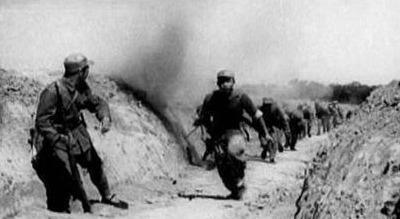In the War of Resistance Against Japanese Aggression in 1938, due to the extension of the front line, the weakness of insufficient troops of the Japanese army was increasingly exposed. In the vast areas occupied by the enemy, the Japanese garrison was weak, creating favorable conditions for carrying out guerrilla warfare behind enemy lines and creating anti-Japanese base areas. At this time, the Eighth Route Army extensively carried out guerrilla warfare in North China and continuously expanded the anti-Japanese base areas, which seriously threatened the enemy's rear.

The Eighth Route Army is in combat
In the autumn of 1938, after occupying Wuhan, the Japanese Kou adjusted their strategic deployment and gathered about 50,000 troops in north China to concentrate on dealing with the people's armed forces led by the party behind the enemy lines, and the young Jin-Cha-Ji Border Region became one of the important targets of the Japanese-Kou's frenzied "sweeping.". The enemy army changed the previous method of operation of driving straight ahead, adopted a gradual advance, compressed the encirclement, and then divided the policy of "clearing and suppressing" and breaking through each one, in an attempt to annihilate the main force and leading organs of our army.
The headquarters of our Eighth Route Army is determined to adopt the operational policy of combining the internal and external fronts, guerrilla warfare and mobile warfare, and to constantly harass, deplete, and exhaust the enemy with small detachments, militias, and guerrilla units, and to conceal and wait for the opportunity with the main forces, to find the right time to annihilate the enemy," and to resolutely take the initiative to fight back against the enemy's "sweep."
In October 1938, Wang Zhen, then brigade commander, led the 359th Brigade of the Eighth Route Army in a beautiful Shaojiazhuang ambush in the Jin-Cha-Ji Border Region, and wounded Japanese Lieutenant General Hiroharu Tokioka.
On October 25, Lieutenant General Hiroharu Toshioka, commander of the 2nd Independent Mixed Brigade on the Northern Front of the Japanese Army, led 1 squadron of infantry, 1 squad of heavy machine guns, 1 squad of artillery, and a radio detachment of more than 200 people from Zhangjiakou to inspect Weixian, Guangling, Lingqiu and other places. Upon learning of the situation, the 359th Brigade resolved to annihilate the enemy. The 359th Brigade immediately held a meeting of cadres at and above the regimental level, and the main leaders of the 717th Regiment, the 718th Regiment, and the 719th Regiment participated. Brigadier Wang Zhen drew a map of the situation between the enemy and ourselves on a door panel and gave the brigades operational tasks: the main force of the 719th Regiment and the 9th Company of the 717th Regiment were ambushed at Zhangjiawan and Shaojiazhuang, 10 kilometers south of Guangling; the 718th Regiment was ambushed in the vicinity of Huangtai Temple, 10 kilometers north of Lingqiu, to block reinforcements.
On the 28th, Tokioka Kanji led more than 200 people from Wei County to enter a narrow ravine 500 meters long in Shaojiazhuang. The 9th Company of the 717th Regiment, which was hidden in Zhangjiawan, suppressed the enemy with fierce fire according to the operational deployment, and when the enemy was in a panic, the main force of the 719th Regiment quickly approached the enemy who had not yet had time to carry out its firepower and rushed to fight fiercely. Dozens of devils who collapsed into an army huddled under the car, stubbornly resisting with the help of the carriage. Just 20 meters away from the enemy, Peng Qingyun, an instructor of the 3rd Battalion, raised three or eight large covers, aimed at the next ghost soldier wearing a white velvet jacket under the car, and shot him. It was later confirmed that the man who was hit by Peng Qingyun was Lieutenant General Hiroshi Tokioka. In this battle, about 200 enemy personnel were annihilated, 5 enemy cars were destroyed, and a batch of materials were captured.
Bethune is operating on the wounded
But unfortunately, at the same time as hitting Changgang Kanji, Peng Qingyun's right elbow was also injured by the enemy, bleeding more, and the injury was serious, fortunately, Bethune rescued in time and resolutely performed amputation surgery to get out of danger. Bethune also personally sacrificed his own blood for him, saying: "It is better to save one warrior than to kill 10 enemies!" This instructor, who had his right limb amputated, was awarded the rank of major general in 1955 and became one of several "one-armed generals" in our army.
Major General Peng Qingyun